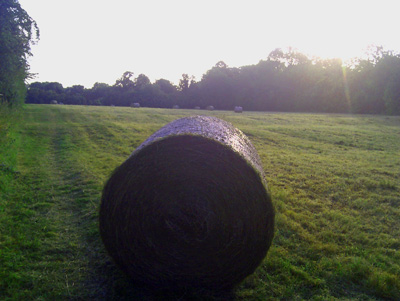One of my favourite paintings — and one that is very germane to The Angel’s setting is John Nash’s The Cornfield, which I’ve blogged about previously. It’s relatively well-known, providing a motif for David Dimbleby’s BBC series on landscape painting a couple of years ago and can be viewed here on a link to the Tate Britain website.
Clearly the painting captures a specific moment in the agricultural year — the bringing in of the harvest — and as it was painted in 1918 it predates any mechanisation. The Nash painting depicts a line of wheatsheaves (amazingly the word ‘wheatsheaf’ isn’t in my wrist-sapping Oxford Dictionary of English). They’re portrayed almost anthropomorphically as semi-human figures (a little like monks with hassocks tied around their waists) and they look tired, weary and irregular, but still form a semblance of a line, much as one might imagine was the mood of the country at the end of the First World War.
I took the photograph below at 6.30am on the 15th July (St. Swithin’s Day — as immortalised by David Nicholls) on the way to get the train. (This is my bucolic route to the local station, which is wonderful on a July morning but awful on a rainy, muddy January evening). I’d walked the opposite direction the previous night about 6pm, when the grass had been cut but not baled. One point about the reduction in the number of farmers is that when the remaining farmers are busy, then they’re really busy. When the wheat is ready to bring in the combine harvesters work through the night. So it’s not surprising that the cut grass had been baled over the course of the previous evening.

Although these bales are of meadow hay and not corn (which meant wheat when Nash painted his picture) I later realised that there was something of a parallel. Rather than sheaves that are designed to be gathered in the arms, these cylindrical bales are so huge they can only be moved by a fork-lift truck (or its tractor equivalent) — there are no more than a dozen of them in the field, which must be a good three or four acres. So my photo, with its long shadows, Â is similar in spirit to Nash’s painting but also shows the differences.
I was reminded of Nash because I paid a brief visit today to Tate Britain in Millbank, which is where The Cornfield is on display. I didn’t have time to go into their current Watercolour exhibition but I saw a few reproductions of the pictures elsewhere in the gallery. I was particularly struck by Eric Ravilious’s The Vale of the White Horse, featuring the genuinely ancient prehistoric monument which is just off the Ridgeway in Oxfordshire.
If you were to follow the Ridgeway from the Uffington White Horse north-east for about fifty miles, you’d end up at The Angel (in fact I might use a bit of artistic licence and have the Ridgeway go past the front door, as it does at The Plough at Cadsden). And Kim will be wonderfully excited about the connection between the land and  the art — she’s going to take the Nashes and Revilious as inspiration.
There’s also a profound irony about Kim’s interest in Ravilious — like the Nashes he was a war artist — but unlike them he died in action. He was killed in an air-sea rescue mission in 1942 off Iceland.
Another serendipitous connection is that there is a brewery named after the White Horse.Their beers include two that are well-known to me — Wayland Smithy and, er, Village Idiot.
